“Isn’t oblivion through alienation, ignorance or
vainglory likely to leave deep and lasting scars?”
(Edouard Glissant: “Tous les jours de mai”, 2008)
Because of a minimum of three months’ travel to get there, and given the small number of King’s subjects among the population, Versailles were able to draw up the laws but were clearly not in a position to enforce them. Hence the swift choice among Creoles to come up with a roughly codified custom in the same way that Lazarist missionaries had their own custom . There were derogations within the military, as witnessed by a recently-arrived officer seeking to examine his so−called ‘white’ garrison: “Among the many officers and fusiliers, the number of those stained with colour is so considerable that there is no way of sorting them out without causing the greatest schism and misfortune in this colony” . Turning to assistance from notaries was very common, even among the poorest. As Claude Wanquet wrote: “In short, the island was invaded by procedure. (…) In such an atmosphere, legal experts became abundant, with the number of notaries increasing to an indecent number .
And above all, the people of Bourbon claimed their own right to distinguish between skin colours, almost a law within a law: article V of the ‘Code Noir’ of 1723 stipulated that children issued from “cohabitation with slaves (…) were to be sent to the local hospital without ever being freed”, but this article (which did not exist in the 1685 version) was never applied. The same was true for article LI, which prohibited donations from whites to the Freedmen.
In this society based on appearances a code of honour was established. The hierarchy of colours was not contested as such, but its application was managed by the Creoles . Here are some of the most significant examples:
– the case of the Ranga sisters, three sisters and three different ‘colours’: Catherine was ‘black’ because she was a slave, Anne was a ‘Freedman of colour’ and Marie was ‘white’ because she was married to Sieur Maillot .
– the mention of the word ‘Creole’ in the 1780 census of Denis Decottes in Sainte-Marie. This same word covered three groups: white, free (‘daughter of a Freedman’) and slave .
– Bory de Saint-Vincent’s famous visit to the Kerautrays in Saint Joseph in 1801 has been described many times :
For his expedition to the volcano, Bory de Saint-Vincent was accompanied by a porter called Cochinard. In search of food for the night, one of the blacks in the group recommended a ‘hospitable white man’ by the name of Kerautray. He then turned to a ‘mulatto’ to ask him if he knew this gentleman. ‘But I am him!’ came the reply. And they were invited to his house. “Upon arriving, Mr. Kerautrai said to his wife, who got up as soon as we entered: ‘My darling, here are some white people passing by, help them to get cleaned up and give them dinner. Immediately they brought us some rum. Mr. Kerautrai was very appreciative when we drank to him and to his health. After that he pulled me by the sleeve, led me outside as if it were a great secret, and, showing me Cochinard, he asked me if he was white, free, or black? Although Cochinard was only free, and his colour quite dark, I answered, without hesitation that he was white. Put out four plates, Kerautrai shouted to his wife. He then invited our blacks to eat with his four slaves in a hut just twenty paces from his.” (book listed in footnote, pp. 310-311).
– And finally this travel journal from the 1840s: “when you look closely at the slave population of Bourbon, you will be surprised to discover that it is not only made up of Negroes, but also of Malays, Bengalis, Malabars and even whites” .
And so, one denial followed another. The first and most harmful concerned the denial of humanity for slaves who were sold and referred to as ‘Indian furniture’. The second denial was the use of colour to avoid reification. The Creole language avoids using the word ‘ras’ (race) and more often replaces it with ‘nasyon’ (nation). However, while colour was not named, it was difficult to fight racism, which became deeply rooted as a collective and traumatic memory: ‘Mwin pa blan / Non mwin pa nwar / Tarz pa mwin si mon listwar”(I am not white, I am not black – do not lie about my history) . In this divided society, the Creole was a master in the art of identifying and judging. But who would take a step back and who would come forward to take command? It is now clear why social categories that are of little demographic, economic and political importance are so much in question today. The genealogical history of the island’s colonisation is necessary so that families can appropriate their history. For in the hellish world of slavery we can find treasures of humanity that we have no right to leave hidden in shame.
The only difference between the Code Noir of 1685 (for the West Indies) and that of 1723 (for the Mascarenes) was a certain desire to limit the legal category of the Freedmen of Colour as much as possible. The slave-owning powers-that-be had foreseen that this group could become dangerous to the public order. In fact, Toussaint Louverture, Delgrès, Bissette and Houat all belonged to this social class. Generally speaking, the governors of the royal period (and especially Bellecombe) were very miserly in granting emancipation, something which could only be done with their approval.
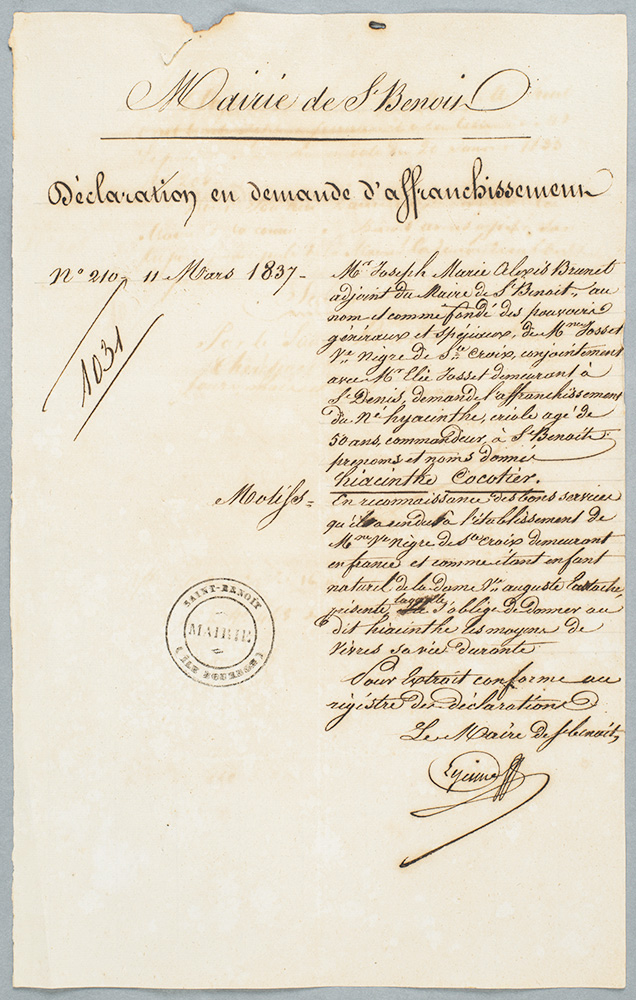
Desforges Boucher was a special case: he started here as a storekeeper and, when he became governor, he had a castle built at the Gol and freed twelve of his slaves, including a butler.
Thus, at the end of the royal period, the percentage of the Freedmen of Colour among all free people was very low compared to the other French colonies: they represented just 11% of the total number of free people in Bourbon compared to 43% in Saint-Domingue.
During the revolutionary period, the Colonial Assembly used the Freedmen of Colour against the abolitionist threat.
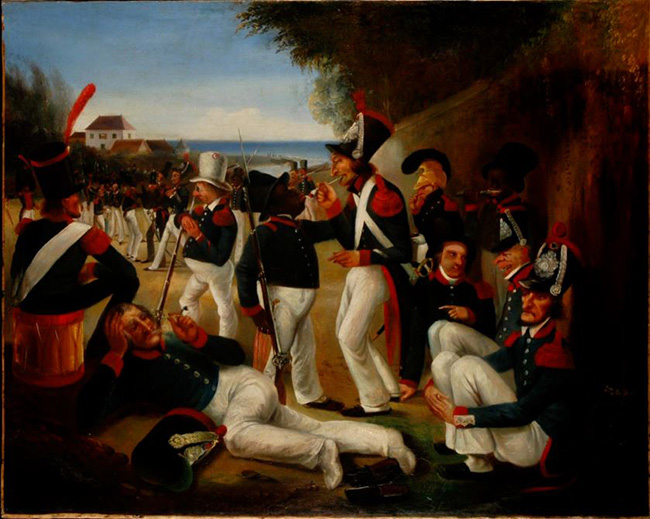
The English used emancipation to form a Bourbon Regiment. According to Danielle Miloche-Baty, they numbered 653, which is close to the number of soldiers mobilised in this regiment (685 in total, including 28 officers and 89 non-commissioned officers) . They paraded in Port-Louis on 4th October 1812, causing a stir among Mauritian colonists .
During the Restoration period, emancipation almost came to a complete stop.
The July Monarchy tried to find solutions in the most shocking situations, such as those of recognised births, ‘Freedmen of the savannah’ or even repurchases thanks to money saved. The royal decree of 12/07/1832 granted a surname to Freedmen who were then declared in the Civil Registry as ‘born’. These registers included both whites and Freedmen. Louis-Philippe wanted to normalise social relations and, more assertively after 1840, to prepare for widespread abolition.
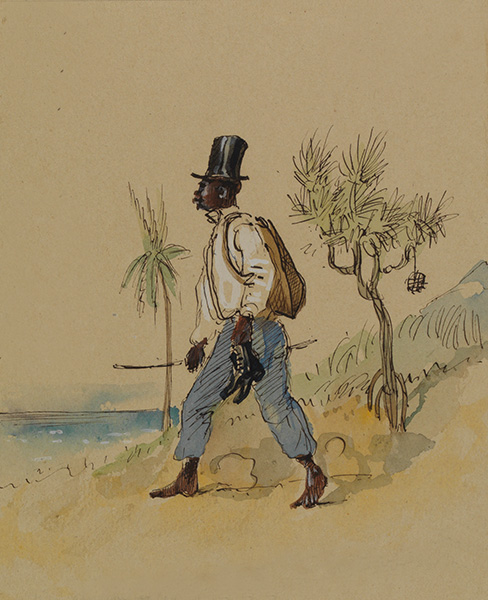
The general emancipation of 1848 took place very differently in Martinique and Reunion Island. In Martinique the Freedmen of Colour were very influential. Bissette may have been ousted (despite his legitimacy as an abolitionist), but Perrinon (a Freedman of Colour) was appointed commissioner of the Republic. During the session of the Privy Council of 15th June 1848, he declared: “The desire was to ensure that Freedmen could join society under the same apparent conditions as the other citizens (…). Surnames will therefore only be given with each individual’s consent and by specially accredited employees or officials across the colony” . In Reunion Island, no one ever went out to the plantations to keep records. Despite Perrinon’s wishes, the slaves were not asked to choose a surname for themselves. No time was taken to draw up the registers or even to vote before any surname was established. Here, the commissions were presided over by the rich white landowners and they worked quickly. However, 20th December came to stop owners who wanted to maintain control over ‘their’ Freedmen.
The power of giving surnames was connected to policies governing colour. “In a way, we can say that with his surname, each individual carries his own history and origins” . This power was exercised by the master, who could free individuals whilst still keeping them nearby, close to either the master or the estate. Then the registrar would intervene quite arbitrarily, disputing this power with the slave-owner. When named in this way, they often were known as the Freedman of Mr or Mrs, or even of Sarda.
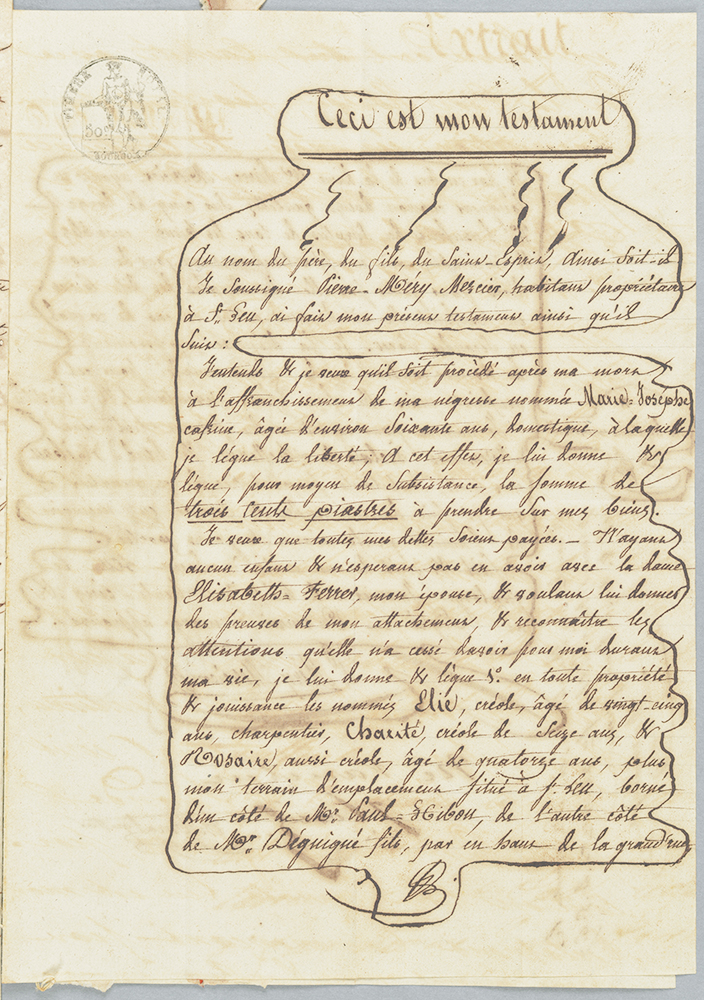
Until 1832, Freedmen would keep the first names they were given when baptised, but were not entitled to a surname. But they would try to earn one for themselves. Censuses of the Ancien Régime provide much information on this subject, as they were written by the inhabitants themselves and were signed by the district commanders. Several strategies were used to ‘earn their name’. Some used their property and its immediate surroundings (a gate, bridge, gully or woods) to give them an identity. But more often than not one, the names came from the family. A Father’s first name was often used as a surname, and the mother’s as well, especially when she was the one responsible for emancipation. It was difficult to escape the preposition ‘de’ which indicated the individual to whom people owed their name.
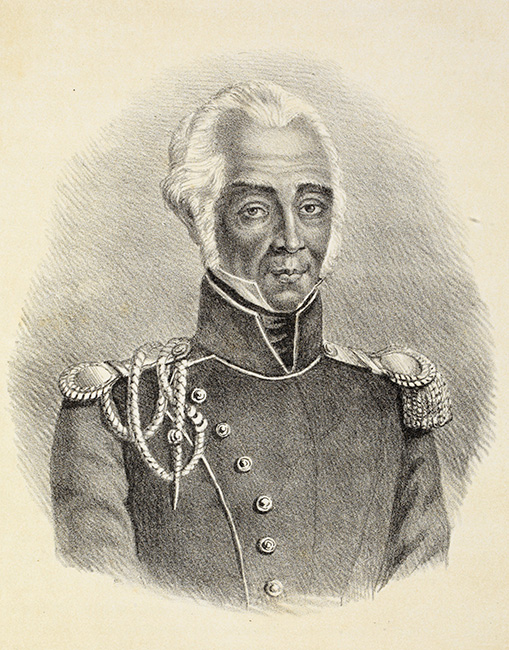
Louis Antoine Roussin. 1881. Lithography.
Léon Dierx Museum collection
Niaman” . Although his influence on Bourbon Island during the 19th century was limited, his legacy is a source of pride for the Reunionese today.
“On 23rd August 1786, for his thirty-first birthday, he was elected as a correspondent of the Academy of Sciences of Paris. He was the first man of colour to receive this honour. His sponsor was the Duke of La Rochefoucauld-Liancourt, cousin of the King. The Academy of Sciences recognised his scientific value, of course, but above all, through this distinction, it marked their faith in the new values conveyed by the Encyclopaedia. It was the beginning of the fight for Human and Citizen’s Rights, and for the abolition of slavery. Lislet was a symbol among progressive intellectual circles three years before the beginning of the French Revolution. His knowledge of the coasts and maritime routes was of great strategic and economic importance. All his life, Lislet sought to draw up increasingly precise maps, continuing and completing the work of Rochon and Abbé de Lacaille in particular. He was largely responsible for the final maps of the Mascarene Islands, and the expedition to the Bay of Sainte Luce truly marked the beginning of Jean-Baptiste Lislet’s career as a geographer and cartographer: 1793, map of the Seychelles; 1797, map of the Bourbon Islands and France; 1814, map of north-eastern Madagascar (published in London); 1819, general map of Madagascar.” (http://aphgreunion.free.fr/Lislet_Geoffroy.html consulted on 12/10/2019, article by Christian Landry).
The Freedmen of colour had much less influence on surnames than escaped slaves or the urban nomenclature dominated by the whites, in keeping with their historical influence. One of the richest among them discovered a spring in Le Tampon that now bears his name. In 1848, Reihlac owned 84 slaves in Saint-Pierre. From the Lacaussade family, also prosperous, it is Auguste we remember the best, who left us with these poetic lines:
O harsh servitude! O fate! O cruel laws!
At the yoke of man, man is thus bent
Ah! Far from these distressing paintings, let us spread our wings!
Let us run away, sweet Bengali! Let us run away to forget
(from ‘The Workers’, in Poèmes et paysages)
As for Célimène, the ‘Muse of Trois Bassins’, how can she be seen as exemplary after having said that “the horse ennobles the mule”?
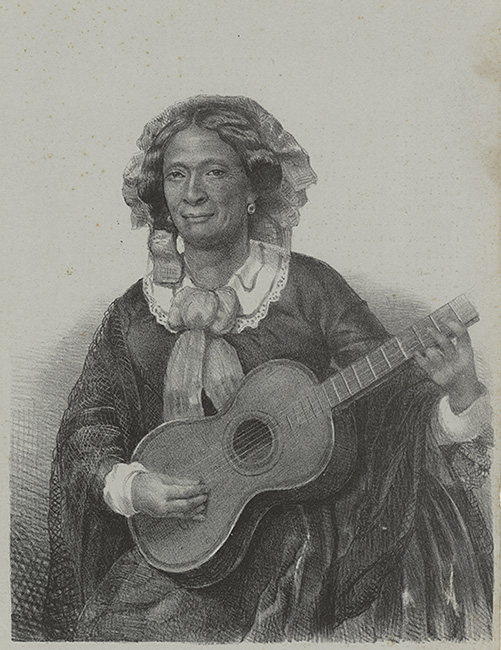
Does this mean that none of these Freedmen fought against the policies concerning colour? It would be a great injustice to claim so. First of all, these people were by far the most active in freeing slaves: Freedmen of colour emancipated four times as many slaves as white men, and free women of colour fifteen times more than white women!
The reality is that the colonial authorities set up ruthless policies around colour. From the time of Mahé de La Bourdonnais, any Freedmen who captured or killed an escaped slave would receive a slave as a reward; any slave who denounced a plot (imaginary or not) became a Freedman… And everything that came with it. The first to rise up against this atmosphere of terror were victims of merciless repression. During the turmoil of the French Revolution, Jean-Jacques Ramalinga and Guillou Dubertin were banished, the first without any trial, and the second without any proven charges against him.
Then there was the case of Furcy. Bolstered by his given right to be released from servitude under Lory, and with the support of Sully Brunet, he brought a lawsuit against his master which lasted from 1817 to 1843. There were two more trials in Bourbon in 1845. What is revealing is that Lory became frightened, despite the support he received from the Desbassayns clan who unofficially ruled the island at the time. He preferred to send Furcy to Mauritius so that he would not become an example to others, a leader capable of making things happen. While legally free in Mauritius, Furcy worked as a confectioner, and was able to correspond and pay the necessary legal fees.
The story of Timagène Houat is even more telling. It remained hidden for a century before his book, Les marrons, Reunion’s first ever novel, was republished in Reunion Island, first published in Paris. But this individual was more than just a writer, as he was Reunion’s first true abolitionist. So here is his story, the one we like to tell and which gives us hope for our island . Born in Bas de la Rivière Saint-Denis on 12th August 1809, Timagène kept his African name. His father came from Port-Louis and was a bridge and road builder. At the age of 18, Timagène wanted to open a school in his neighbourhood of La Rivière, but was refused by the Director of the Interior. “In 1830, in a house located on the corner of Rue des Limites and Rue du Grand Chemin, Louis-Timagène Houat ran a free school for all the young people in his neighbourhood, introducing the more gifted to music (guitar or violin)” . Together with Charles de Sigoyer, he applied to be a member for parliament, representing Bourbon in 1834. In September 1835 he wanted to organise a demonstration in the capital, with the aim of asking the governor for the abolition of slavery: “We will impose our will by our numbers, but I do not want there to be any crimes committed against whites”. Denounced, this demonstration never place. Instead, a court case for a so-called conspiracy was organised. Houat’s crime: corresponding with Cyrille Bissette, receiving his newspapers and reading it to slaves around him. On 10th September 1835, Timagène was put into solitary confinement and sentenced on 3rd August 1836 with three others to be deported. Three other Freedmen were sentenced to five years in prison. Four slaves were sentenced to life imprisonment and deported to Sainte-Marie Island. In spite of the pardon granted on 18th June 1837 by King Louis-Philippe, the sentence was carried out and Timagène found himself in Paris. The Court of Cassation, however, expunged him of this sentence.
Genealogical work revealing family histories shows that the families of the period around 1848 were constantly humiliated and crushed in their efforts to progress. They had been deprived of their history, and wanted to be able to rebuild their lives. But they also had to understand that it was not by denying their ancestry and victimizing themselves in front of theirs masters that they would regain their honour. Their ancestors were not just slaves but men and women, quite simply. Their dignity had to be restored to them wherever possible. The question of surnames, and that of appointments in public spaces and institutions is therefore of great importance. The Department and its museums cannot dodge this question: what name should be given to the only slavery museum on the island?